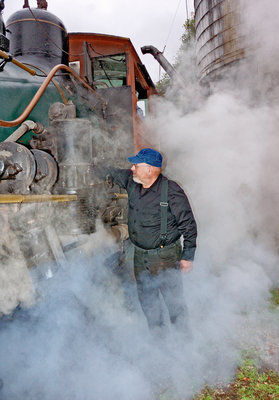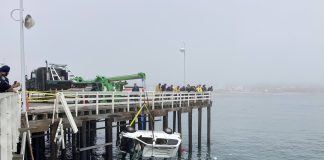
It’s been 40 years since Tom Shreve joined Roaring Camp Railroads to prepare food for eager steam-train riders in the redwoods.
He took the weekend and summer job to make some money while he earned his zoology degree from San Jose State University. His first day was Sept. 22, 1972.
What he didn’t know was that it would become his lifelong passion.
In 1976, he became an engineer, and today he is the senior locomotive engineer and mechanical lead for the esteemed tourist destination that serves about 250,000 riders from around the world each year.
“It’s one of those jobs you fall into,” said Shreve, who lives in Felton. “You can’t plan to become a steam engine operator.”
Shreve has learned the whole business — track maintenance, welding, machine work, shop work, railroading history and customer service.
Maintenance is the name of the game for Roaring Camp. Every hour on the tracks requires roughly an hour of maintenance on the four operating steam engines at Roaring Camp, Shreve said.
“Roaring Camp is unique — we’re one of the toughest railroads in the United States,” Shreve said. “It’s a six-mile roundtrip, the grades are among the steepest and the curves are as sharp or sharper than some of the streetcars in San Francisco. Guys who run on narrow gauge could probably operate safely on almost any other railroad.”
Shreve and his crew have developed a connection with the rails. Engineers must listen to the squeal, feel the way the cars are breaking and taste the water to tell how soft it is.
Using hard water causes mineral deposits to build up, hampering the operation of the boiler in the steam engine.
It’s a team effort to run the machines, which are in some cases a century old. The fireman makes the power by burning used motor oil, which heats water, causing pressure to fire the pistons inside the engine. The engineer uses the available power as the train climbs the tracks.
“A steam locomotive in a museum is like a stuffed animal in a museum,” he said. “You don’t see the animal in its environment, how it moves. You don’t hear it growl, you don’t see how fast and slow it moves. It’s the same way with a steam locomotive. Those things have a life. They can feel alive. They’re not alive, but they’re the next best thing to it.”
In 40 years, little has changed at Roaring Camp.
“It’s keeping the status quo, keeping the cars and engines in working conditions,” he said. “We keep an eye on what we have and keep it up. It’s an expensive proposition.”
Parts are hard to come by, because few steam engines are still running, so many times they are repaired by Shreve and other employees, rather than replaced. Machine work was a trade passed down from former employees, Shreve said.
Shreve also acts as the resident blacksmith, having assembled a replica blacksmith’s shop, including a 100-pound anvil, on the grounds to show visitors what that business was like in the 1800s.
“It gives people an idea, a sense of what a blacksmith did,” Shreve said.
The engineer has been injured on the rails — a severed quadriceps tendon damaged by a wrench in 2001 put him out for nine months — and has seen his share of mishaps, including trains going slightly off the tracks. He also remembers the storms of 1982, when trees and mud fell across the tracks, and a fire in 1976 that shut down the corkscrew loop trestle that used to be the route the trains took up Bear Mountain.
But his favorite part of the job, interacting with visitors to Roaring Camp, is what keeps him excited.
“To see the little kids and talking to adults — to show people what something was like during the old days,” Shreve said. “I do exactly the same thing in my work a guy 50 or 100 years ago did operating steam locomotives.”
When will Shreve, 61, step down from his post as senior engineer?
“When they pry my cold, dead hand off the throttle,” he said. “I intend to stay with Roaring Camp one way or another until I no longer can.”
To comment, email editor Peter Burke at pe***@*********er.com, call 438-2500 or post a comment at www.pressbanner.com.











